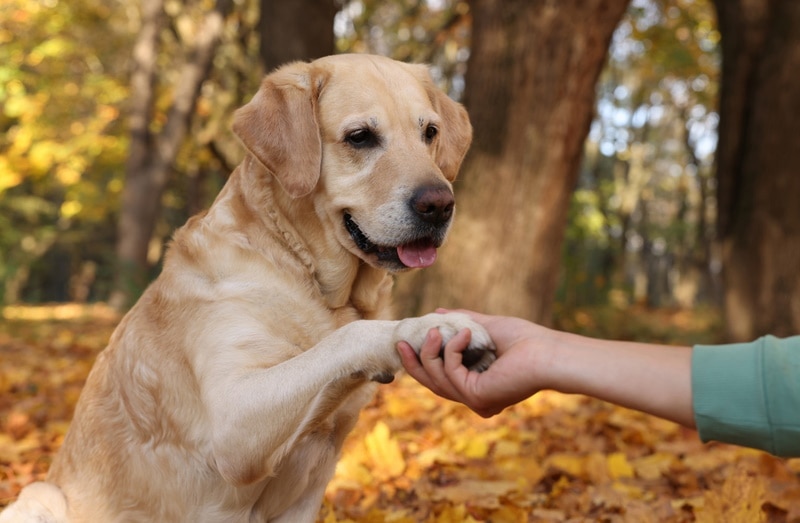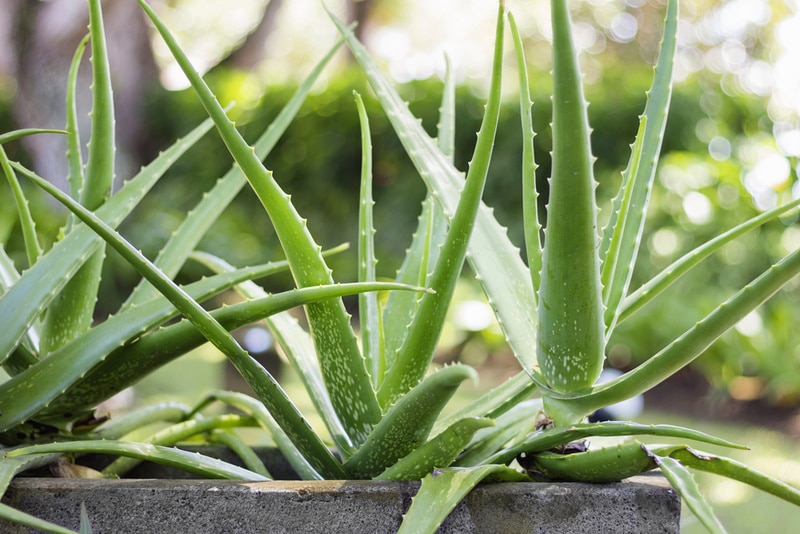Can I Put Aloe Vera on My Dog’s Paws? Vet Approved Facts, Precautions & Tips
By Ed Malaker
Updated on

As pet owners, we want to provide the best care for our pets, and one question that many people have is whether aloe vera is safe for dogs. After all, it has been so helpful to humans for ages. The short answer is yes, but only if you apply it correctly. Keep reading as we explain how to use it and provide a list of benefits and possible dangers to help you be better informed.
What Is Aloe Vera?
Aloe vera is a succulent plant that’s native to the Arabian Peninsula but is grown all around the world for its medicinal properties. It contains a thick, clear gel that’s rich in vitamins and minerals, amino acids, and antioxidants, and people have been using it for centuries to soothe and heal skin conditions. Its uses include moisturizing dry skin and reducing the burning sensation after a sunburn, and you will also find it in many different skin care products.

The Benefits of Aloe Vera for Dogs
Aloe vera has natural anti-inflammatory, antibacterial, and antifungal properties that can help your pet with various skin conditions. For instance, it can help relieve itching and irritation caused by allergies, dryness, or even insect bites. It can help minor cuts and abrasions heal faster than they might on their own, and it can reduce the risk of infection. Aloe vera also helps moisturize the skin, which can soften and soothe dry, cracked paws.
Is Aloe Vera Safe for Dogs?
First, only the clear-colored crystal gel part of the plant should be used. The yellowish layer that is immediately beneath the green rind or cuticle of the aloe vera plant is called the latex layer and is considered toxic because it contains anthraquinones and saponins. Both the rind and latex layer should be discarded; only use the crystal gel center of the plant to apply to your dog’s paws.
While aloe vera gel can benefit dogs, it’s important to use it cautiously because not all dogs will react the same way to it, and some might even be allergic. Signs of an allergic reaction include redness, swelling, hives, and itching. If you notice these after applying aloe vera to your dog, stop using it immediately and call your veterinarian. Also, remember that many skin care products contain other ingredients besides aloe vera that might be harmful to your pet, including alcohol and essential oils, so read the package carefully, and check all the ingredients before applying it to your pet.

How to Use Aloe Vera on Your Dog’s Paws
- After removing the outer cuticle and latex layer of the plant, use fresh aloe vera gel straight from the plant when possible. This will ensure that there are no added ingredients that might be harmful to your dog.
- Test a small amount of aloe vera on a small patch of your dog’s skin to ensure that there are no allergic reactions before applying it all over their paws.
- You only need a thin layer of aloe vera gel on your dog’s paws to be effective. Apply a small amount and massage it gently into the pads.
- While aloe vera is safe for your pets to eat in small amounts, it might upset their stomach, so it’s best to prevent your dog from licking their paws after applying it, especially if you are using a product that contains added ingredients.
- Use aloe vera to help soothe and heal your dog’s paws as often as needed. If they are particularly dry or cracked, you may need to apply it several times before seeing good results.
- Consult your veterinarian if the aloe vera doesn’t seem to work after several days, and ask for advice.
Alternatives to Aloe Vera for Dog Paw Health
Coconut Oil
Coconut oil can be a great alternative to aloe vera, and it’s a natural moisturizer that can help soothe and soften dry skin. Like aloe vera, it has natural antibacterial and antifungal properties, which can help increase the rate at which cuts and other small abrasions heal.
Oatmeal
Oatmeal is a natural anti-inflammatory that you can use to help relieve itching and irritation on a dog’s paws. You can make an oatmeal soak by mixing ground oatmeal with water and soaking the dog’s paws in the mixture. While it has no antibacterial or antifungal properties, oatmeal is extremely easy to find and inexpensive. However, if your dog has a history of yeast infections, please do not use this method.
Calendula
Calendula is a natural anti-inflammatory and anti-septic that is safe for soothing and healing a dog’s paws. Make an ordinary calendula infusion, and let it cool before soaking your dog’s paws in it.

Other Tips and Tricks
- Check your dog’s paws often, and clean them with a damp cloth or baby wipe to remove dirt, debris, and other foreign objects that might get trapped in the paws and cause irritation or infection.
- Regularly trim your dog’s nails, especially if you hear them clicking on the floor as they walk. Overgrown nails can affect the way that your pet walks and put extra pressure on the paw pads, which might lead to drying and cracking.
- Consider using booties or paw wax to protect your dog’s paws from extreme temperatures and rough surfaces. Hot pavement, ice, and cold snow can be hard on a dog’s paws, leading to drying and cracking.
- Regularly inspect your dog’s paws for any signs of injury, including punctures, scrapes, or cuts, and consult with the veterinarian immediately if you notice anything.
Conclusion
Aloe vera can be a safe and effective natural remedy for treating dry and cracked paws, and it can also help heal minor scrapes and abrasions faster. However, it’s important to test your dog’s skin first to see if they are allergic to it and to check the ingredients of any skincare products that you are considering using to ensure that there is nothing potentially dangerous. Use fresh aloe vera crystal gel when possible. If you’re unsure, contact a veterinarian for advice, and check your dog’s paws frequently so you can start treating any problems quickly.
Featured Image Credit: New Africa, Shutterstock












